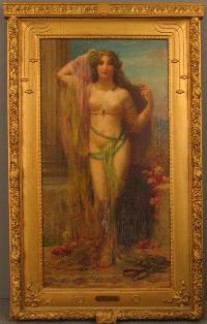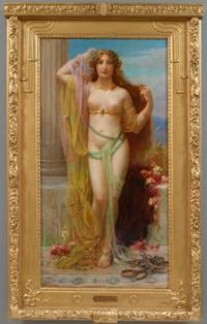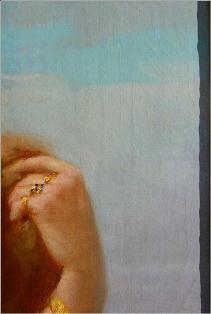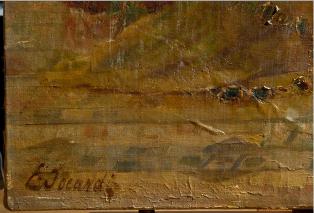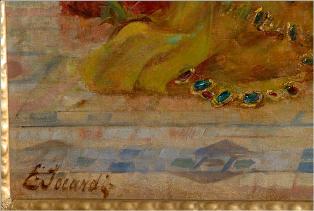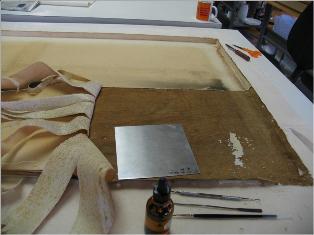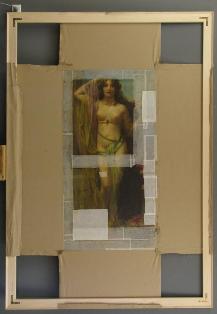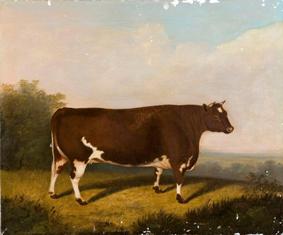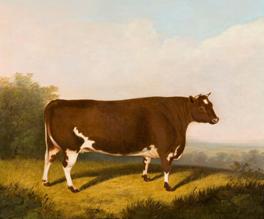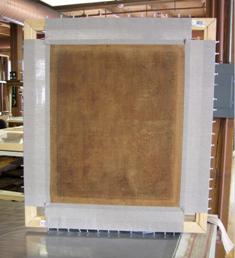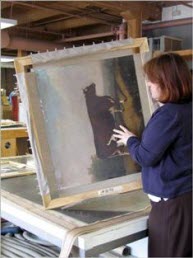(Above) Standing Nude, pre-treatment and post-treatment
At The Center, we see numerous works on a daily basis that have been damaged to varying degrees. Severe shrinkage of a canvas can devastate a painting if not addressed quickly and accurately by trained conservation personnel.
We successfully treated two paintings: both of which had experienced moisture damage to the extent that shrinkage of the canvas occurred, causing injury to the paint layer. In both cases, it was necessary to re-stretch the canvas in order to begin the restoration. There are several techniques to stretch canvas. However, when loosening of the paint and/or ground layers along cracks where the layers lift upward into peaks (a process called “tenting”) is evident, the most effective technique or method to us is the “Dutch Method”.
The Dutch Method is a technique that was used in Europe as many as one hundred years ago, and was used originally as part of the lining process during restoration. It is a method where the conservator removes the painting from the stretcher, removes the old lining canvas (if applicable), and flattens the margins. Strips of craft paper are then adhered to the margins, wetted and stretched onto a larger strainer. As the craft paper dries, the shrinking process carefully pulls the canvas, allowing the tented paint layer to settle back onto the surface. The Dutch Method is supreior treatment that slowly and safely reverses severe shrinkage in canvas.
The first painting, Standing Nude (figure 1-2, below), sustained severe water damage. The stretcher was wet for an extended period of time, causing the canvas to shrink. This, in turn, caused the delamination of the paint layer, which is separation of the layers of the ground, paint and/or varnish layers. Complicating the situation, the painting had been restored in the past: it was lined, old fills were cracked and the inpaint was discolored.
Detail, pre-treatment (left, above and below): water damage was the cause of the tenting paint and delamination. Post treatment, right (above and below)
Given the fragile condition of the painting, structural stabilization was required, including the removal of the old canvas lining. The canvas required stretching, using the Dutch Method, in order to allow tented paint layer areas to again lie on the canvas. It should be noted that the surface of the painting was faced with Japanese tissue paper wetted with sturgeon glue in order to protect the painting from damage. After, the canvas was humidified. When stabilized and consolidated, the paint layer was then cleaned of grime, old varnish, old inpainting and overpainting, and fills. The next step was to then line the painting to a new, sized linen canvas, stretched out on a new custom-built stretcher, and varnished. New fills were textured and inpainted with conservation paint.
(Above) Removal of the canvas lining & (Above) Stretching the canvas, using the Dutch Method
The second painting, A Portrait of a Cow (below) had the same problem: shrinkage to the canvas and delamination. Furthermore, lifting to the paint layer of the canvas also had a damaging effect. This canvas was extremely reactive to moisture, possibly due to poor canvas quality. In addition, it had been poorly relined, which exacerbated the moisture problem. The result was a phenomenon called cupping: paint that is aged and loosened by cracking begins to curl upwards at the edges, creating small, cup-shaped formations. The cupping on this particular piece was quite severe, and affected the entire surface area of the paint layer.
(Left) A Portrait of A Cow, treatment in progress (before in-painting): moisture damage caused severe cupping throughout the work. (Right) Post treatment
As with the first painting, the Dutch Method was an effective technique to employ. In this case, due to the poor adhesion between the paint layer and the canvas, adjustments were made in how this method was applied. The old lining canvas was removed. But instead of using paper, as in the previous painting, strips of linen were adhered to the reverse of the canvas. The linen strips were pinned to a strainer using thumbtacks. Stretching was accomplished by carefully restretching the linen strips enough to allow the paint layer to rest on the canvas while it was being humidified. In this case, three restretchings were necessary. Then the old varnish was removed. The painting was then lined to receive a new support, varnished and inpainted.
(Above) Treatment in progress: the Dutch method

